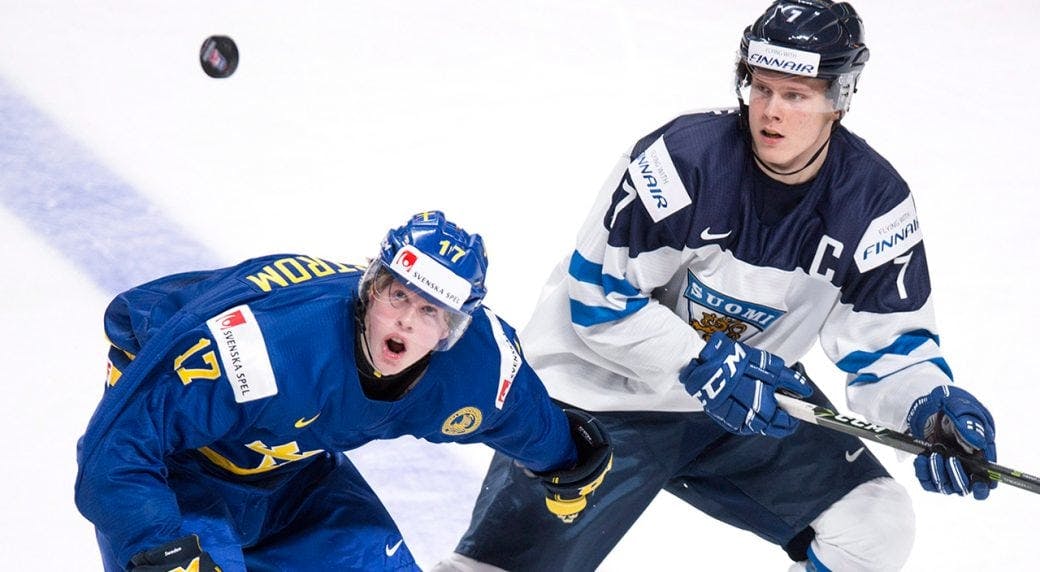Dos and Don’ts for Evaluating Prospects at the World Junior Championship

6 years ago
The world junior championship is my favourite hockey event of the year. I’m also becoming increasingly convinced that most people would be better off throwing the two weeks of international play out the window when it comes time to conduct any meaningful analysis.
I say this because just about every year there’s at least one player who jumps up the prospect rankings based solely on their performance at the international level. I can think of one instance in particular where one scout who shall remain nameless had players shooting up 20 or 30 spots in their rankings after strong showings at the U18s. That shows flawed methodology, to say the least.
That doesn’t mean we can’t gain some valuable insight from the tournament, though. There are just a few things to keep in mind.
Do: use the tournament as an opportunity to compare players in different leagues
Leading up to the draft, one of the hardest elements to account for with regards to first-time draft-eligible prospects is the difference in league quality. Last season, for instance, players were drafted out of leagues as wildly disparate as the KHL, which is considered by many to be the second-best league in the world; to the AJHL, which isn’t even the highest tier of junior hockey in Alberta.
So, when a player like Cale Makar or Tyson Jost gives a lights-out performance on the international stage, it can go a long way towards quelling any doubts scouts might have about players that play against weak competition. Conversely, it can also be a reminder that your favourite team’s prospect who has 3 points in 28 games in the SHL or SM-Liiga is still the real deal.
Don’t: put too much stock in boxcar stats
I’ll save our readers another long treatise on the randomness of goals in a small sample and instead just use a quick anecdote to illustrate this point. In 2009, a pair of Canucks prospects led their teams in scoring with 16 and 11 points respectively, each in six games. Meanwhile, a Dallas Stars prospect finished the tournament at a quaint point-per-game pace, tallying six points in as many games. Even with the benefit of an extra year of development, he just couldn’t keep pace with the other two. The Canucks prospects were Cody Hodgson and Jordan Schroeder. The Stars prospect was Jamie Benn. WJC scoring is not predictive of NHL success.
Do: look at attributes
On the other hand, this is one of the few chances a lot of people will get to see a lot of these players this year. This applies to casual fans especially, who aren’t going to spend heaps of time and money on streaming junior or European leagues in standard definition.
This is a great opportunity to see what players bring to the table, and in HD, no less. Enjoy it.
Don’t: assume the infallibility of coaches/management
This one may seem obvious, but it’s amazing how often you can come across someone who genuinely believes that because player x made his country’s junior team and player y did not, player x must be superior to player y.
The reality is that there’s so much more that goes into selecting a roster for international play. While simply taking the best players available to you may seem like the best and most obvious route (and it usually is), there are also things like matchups, ice surfaces, and chemistry to consider.
It was only a few years ago that handedness kept PK Subban out of Canada’s Olympic lineup. Even with the best players in the world at their disposal, Hockey Canada makes weird decisions sometimes; and you can bet that applies to other countries as well.
On a country-to-country basis, depth is also important to consider, especially as Quinn Hughes sees his stock rise while Adam Boqvist and Ryan Merkley stay at home.
Do: get a sense for each country’s philosophies and strategies
On a related note, it’s also important to be aware of how different national teams have traditionally treated things like deployment and player selection. There’s no sense being down on a first-time draft-eligible player because he didn’t make the team when he had no chance of cracking the roster in the first place.
The WJC has often been called a 19-year-old’s tournament, but this is much more the case for some countries than it is for others. Russia, for example, has a history of stacking the roster with 19-year-old talent while traditionally weaker countries have to take high-end talent where they can get it and will often rely on younger players.
Don’t: Overvalue the tournament over regular-season play
This is what it really all boils down to. The WJC is a great chance to see the best available approximation of best-on-best junior hockey, but it’s just one piece of the puzzle when it comes to prospect evaluation. It can also be pretty unreliable. Players are outside their element, the sample is minuscule, and the quality of teammates and competition varies wildly from team to team. That being said, it’s still a great opportunity to see what players are good at, what needs work, and who you should keep an eye on this June.





